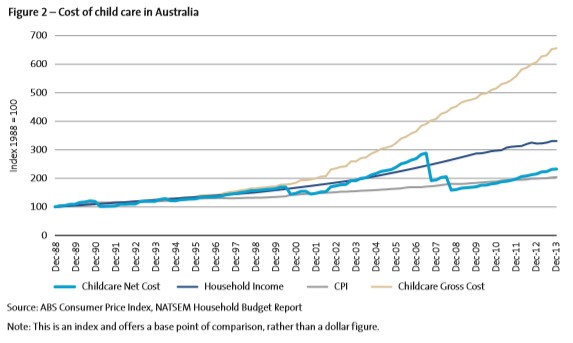In a clear pitch for the family vote, Labor has announced that, if elected, it would significantly boost the childcare rebate and raise to cap at a cost of $3 billion to the Budget. From The Australian:
Parents earning less than $150,000 a year are expected to be the greatest beneficiaries of the policy, with the childcare benefit payment increased by 15 per cent.
About 813,000 families eligible for the payment will receive an increase of up to $31 per child per week, or $1627 per child per year.
The cap on rebates will also move from $7,500 up to $10,000 a year per child, putting an extra $5000 a year in the pockets of some families. That cap will be available to all parents, regardless of family income…
Labor’s policy is set to kick in on January 1 if Mr Shorten is elected on July 2…
It remains unclear how Labor will fund commitment…
It has also shelved the Turnbull government’s plan to introduce a new means test for the childcare rebate that will reduce assistance when families earn $180,000, and opted not to proceed with changes to the work activity test that would ban thousands of stay-at-home mums from using some childcare.
I do not support Labor’s childcare policy.
Last year, the Productivity Commission’s (PC) released its final report into childcare, which recommend (among other things) no overall increase in childcare subsidies, tighter means testing of benefits, and the benchmarking of fees on which to base childcare rebates on.
To a large extent, these reforms were adopted by the Coalition, which to its credit adopted an evidenced-based approach in formulating its childcare policy.
A key risk from Labor’s plan to expand childcare subsidies is that it would be inflationary – much like the first home buyers grant and private health insurance rebate have been – and would act to push-up childcare costs.
One only needs to examine the 2014 report by the National Centre for Social and Economic Modelling (NATSEM), which showed that the average cost of childcare had risen by 150% over the prior decade (see next chart). This is despite government subsidies for childcare rising to over $7 billion a year, up from around $900 million in 1999.

Simply raising subsidies, as announced by Labor, without changing the fee structure system would very likely lead to further cost inflation, potentially leaving families no better-off and the Budget significantly worse-off.
This is where the PC’s recommendation to set the childcare rebate on an hourly rate, benchmarked against the median price of various types of childcare, was so sensible. By doing so, it would encourage childcare providers to keep their fees in check, effectively punishing high cost providers (whose fees are above the benchmark) and rewarding lower cost providers (whose fees are below the benchmark).
In crafting its benchmarking system, the PC stated that the greatest dollar subsidy per hour goes to families who pay the most, which are typically those on higher incomes and sometimes for luxury or premium services.
The PC’s targeting of incentives at lower income families was also very sensible, seeing as it is lower second income earners that face the highest effective marginal tax rates from paid work, whereas those on higher incomes are less effected.
Having an “activity test” for eligibility to childcare subsidies is also wise, with mums/dads only needing to work, study or look for work for 24 hours a fortnight in order to qualify for taxpayer subsidies, which is less than half the average hours worked by second income earners. Exemptions from the activity test are also available for parents with babies, grandparents, children at risk, etc:

An activity test, other things equal, would reduce demand for childcare services at the margin. But chances are, this reduction in demand would come from those that are using taxpayer subsidised childcare more for convenience rather than need, and not materially adding to the productive capacity of the labour force. Moreover, their absence from childcare would also help alleviate the upward pressure on childcare costs, benefiting other more genuine users.
Overall, the PC’s recommendations on childcare struck the right balance, improving the equity and efficiency of the system without further raising costs to taxpayers. The Coalition recognised this, and was sensible enough to implement most of its recommendations.
Unfortunately, now we have Labor intending to ignore the PC’s review with a policy that is likely to be inflationary and expensive, in a short-sighted bid for the family vote.
The PC did the work on this issue and crafted a more efficient and equitable system. Labor should have stuck to its recommendations.

